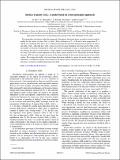Surface of glassy GeS[subscript 2]: A model based on a first-principles approach
Author(s)
Massobrio, C.; Bouzid, A.; Boero, M.; Ori, Guido; Coasne, Benoit Alain
DownloadPhysRevB.90.045423.pdf (1.200Mb)
PUBLISHER_POLICY
Publisher Policy
Article is made available in accordance with the publisher's policy and may be subject to US copyright law. Please refer to the publisher's site for terms of use.
Terms of use
Metadata
Show full item recordAbstract
First-principles calculations within the framework of the density functional theory are used to construct realistic models for the surface of glassy GeS[subscript 2](g−GeS[subscript 2]). Both calculations at T = 0 K and at finite temperature (T = 300 K) are considered. This allows for a comparison between the structural and electronic properties of surface and bulk g−GeS[subscript 2]. Although the g−GeS[subscript 2] surface recovers the main tetrahedral structural motif of bulk g−GeS[subscript 2], the number of fourfold coordinated Ge atoms and twofold coordinated S atoms is smaller than in the bulk. On the contrary, the surface system features a larger content of overcoordinated S atoms and threefold coordinated Ge atoms. This effect is more important for the g−GeS[subscript 2] surface relaxed at 0 K. Maximally localized Wannier functions (WF) are used to inspect the nature of the chemical bonds of the structural units present at the g−GeS[subscript 2] surface. We compare the ability of several charge derivation methods to capture the atomic charge variations induced by a coordination change. Our estimate for the charges allows exploiting the first-principles results as a data base to construct a reliable interatomic force field.
Date issued
2014-07Department
Massachusetts Institute of Technology. Department of Civil and Environmental EngineeringJournal
Physical Review B
Publisher
American Physical Society
Citation
Ori, G., C. Massobrio, A. Bouzid, M. Boero, and B. Coasne. “Surface of Glassy GeS[subscript 2]: A Model Based on a First-Principles Approach.” Phys. Rev. B 90, no. 4 (July 2014). © 2014 American Physical Society
Version: Final published version
ISSN
1098-0121
1550-235X